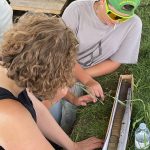
Tag Archives Soil salinity

New soil treatment targets saline patches in fields
A Saskatchewan company’s product focuses on water flow through the soil, offering an alternative to gypsum and organic amendments

Soil sampling for Prairie farmers: How to test for nutrients and avoid common mistakes
Agronomy Management: Take representative soil samples, choose the right depths, analyze key nutrients

Understanding tile drainage
Tiling can be a good solution for fixing multiple problems, but it can also be complex to install, and costs vary widely depending on the farm. Make purchasing decisions easier by doing your homework first.

Moving from dry to wet
Improved moisture conditions can mean different strategies

Prairie soils’ organic carbon climbing
Data from StatCan and AAFC highlight positive changes made in agriculture since the 1980s

Shop smart when selecting seed for salt tolerance
Soil tests are recommended before deciding how best to manage salinity

More on Prairie vegetables and fruits
Part 6 of a series: Let’s look further at what grows well on the Prairies — and when it doesn’t, why

Make it drain: Is tile right for your fields?
A producer and an agrologist consider whether tile is worth your while

Les Henry: The soil salinity story
How it all happened

Les Henry: On salty ground
We’ve come full circle in the soil salinity cycle


